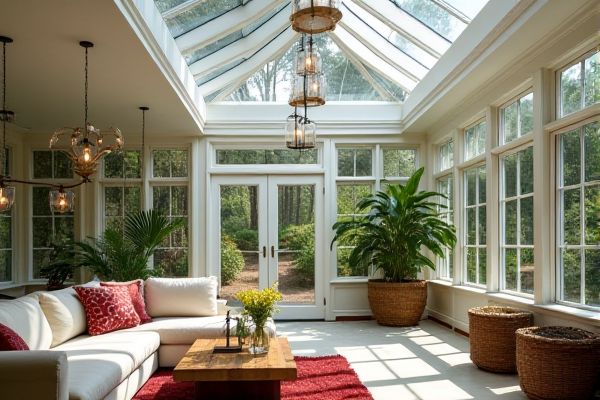
Sunrooms provide a cozy, enclosed space with ample natural light, perfect for enjoying outdoor views without exposure to the elements, while atriums function as spacious, open areas often integrated into a building's interior to enhance light and air flow. Explore the differences between these two architectural features to determine which best suits Your home and lifestyle needs. Read the rest of the article for detailed insights.
Table of Comparison
| Feature | Sunroom | Atrium |
|---|---|---|
| Definition | Enclosed room with large windows designed to let in sunlight | Open central courtyard or glass-covered space inside a building |
| Location | Attached to a building, usually on exterior walls | Typically located in the center of a building |
| Roof Type | Solid, glass, or partially-glass roof | Glass roof or open to the sky |
| Purpose | Living space for relaxation and enjoying sunlight | Architectural feature providing natural light and ventilation |
| Climate Control | Usually climate-controlled (heated/cooled) | Often passive ventilation; may lack climate control |
| Typical Size | Small to medium-sized room | Large central space; varies per building design |
| Usage | Residential and small commercial settings | Commercial buildings, hotels, public spaces |
Introduction to Sunrooms and Atriums
Sunrooms are enclosed spaces with large windows designed to capture sunlight while providing shelter from the elements, often attached to a home's exterior. Atriums are central, open-roofed spaces within buildings, typically featuring glass ceilings to maximize natural light exposure indoors. Both structures enhance brightness and connection to the outdoors but serve different architectural and functional purposes.
Defining a Sunroom
A sunroom is a glass-enclosed space attached to a home, designed to maximize natural light while providing protection from weather elements. Unlike an atrium, which is an open-roofed or glass-covered central courtyard often located inside a building, a sunroom typically extends from the exterior and features insulated walls and roofing to create a comfortable, year-round living area. Key materials include tempered glass, insulated frames, and sometimes climate control systems to maintain temperature and energy efficiency.
What is an Atrium?
An atrium is a central open space within a building, often featuring a glass roof or large windows to allow natural light to flood the interior. Unlike a sunroom, which is typically an enclosed porch attached to the exterior of a home, an atrium serves as an architectural focal point that enhances ventilation and aesthetic appeal in commercial or residential structures. Your design choice should consider how an atrium creates a spacious, light-filled environment that integrates indoor and outdoor elements seamlessly.
Key Structural Differences
Sunrooms feature three or more walls made primarily of glass with a solid roof, designed to extend living space while providing ample natural light and protection from the elements. Atriums are large, open central spaces within buildings, often topped with a glass roof or skylight, serving as a focal point that connects multiple interior rooms and promotes ventilation. The key structural difference lies in sunrooms being enclosed additions to a building's exterior, while atriums are interior architectural features integrating various parts of a structure.
Natural Light and Ventilation Comparison
A sunroom typically features large windows and sometimes a solid roof, providing abundant natural light while offering controlled ventilation through operable windows or vents. An atrium usually has a glass roof and walls, maximizing sunlight exposure and promoting natural airflow through openable panels or vents, creating a greenhouse effect. Your choice depends on whether you prioritize a fully enclosed space with adjustable ventilation or a more open, bright environment that enhances air circulation.
Uses and Functionality
Sunrooms provide a versatile living space that extends the home's interior, offering protection from weather while allowing abundant natural light and outdoor views, commonly used for relaxation, dining, or indoor gardening. Atriums serve as central architectural features that enhance ventilation and light flow throughout the building, often functioning as dramatic entryways or focal points in commercial and residential designs. Both emphasize natural illumination but differ in their integration and primary functional purposes within a structure.
Design and Aesthetic Appeal
A sunroom offers a cozy, enclosed space with large windows that blend indoor comfort with natural light, enhancing your home's warmth and charm. Atriums serve as dramatic architectural features with open, often multi-story glass ceilings that create a striking centerpiece and amplify light throughout the interior. Choosing between a sunroom and an atrium depends on whether you prefer intimate, garden-like settings or bold, open designs that dramatically elevate your home's aesthetic appeal.
Energy Efficiency and Sustainability
Sunrooms often feature insulated glass and controlled ventilation, enhancing energy efficiency by reducing heat loss and gain, which lowers heating and cooling costs. Atriums, typically larger and open to multiple floors, can harness natural light and promote passive solar heating but may require advanced climate control systems to maintain energy efficiency. Sustainable design in both sunrooms and atriums incorporates energy-saving materials, efficient glazing, and strategic orientation to optimize daylight use and minimize environmental impact.
Cost Considerations
Sunrooms generally have lower construction and maintenance costs compared to atriums due to simpler structural requirements and less extensive glazing. Atriums often involve higher expenses linked to their central architectural integration, custom designs, and enhanced ventilation systems. Assessing your budget carefully can help determine whether a sunroom or atrium aligns better with your cost considerations and home value goals.
Choosing the Right Option for Your Home
Selecting between a sunroom and an atrium depends on your home's architectural style and intended use; sunrooms offer enclosed, climate-controlled spaces ideal for year-round enjoyment, while atriums provide open, natural light-filled central areas often integrated into the home's core. Consider factors such as energy efficiency, maintenance, and space utilization to determine which option maximizes comfort and property value. Consulting with architects or contractors specializing in home extensions can help align your choice with structural feasibility and aesthetic goals.
 homyna.com
homyna.com